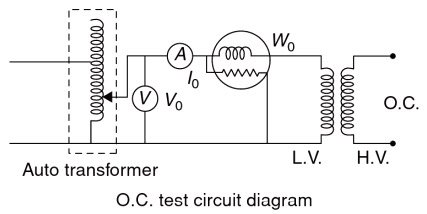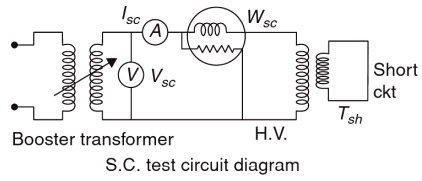For a non-ideal single-phase transformer which of the following is not true?
Right Answer is:
Open circuit test can reveal resistance and leakage reactance of transformer winding.
SOLUTION
A practical single-phase two-winding transformer differs from the ideal transformer as follows:
- The windings have resistance.
- The core permeability p is finite.
- The magnetic flux is not entirely confined to the core.
- There are real and reactive power losses in the core.
Transformer Test
The usual tests conducted on the transformer are
- Open-circuit or no-load test
- Short-circuit or impedance test
- Sumpner’s or back-to-back test
Open-circuit test
The open-circuit test is used to measure core losses and obtain the core loss resistance and magnetizing inductance which is helpful in finding shunt branch parameters of the equivalent circuit.

The current drawn by shunt parameters in a transformer is a no-load current. Therefore the current that will flow in the circuit in the open circuit test is very low so the measurement of the quantities voltage, current, and power must be on the low voltage side so that the corresponding value will be readable in the instruments. And therefore, the open circuit test must be performed on the low voltage side. This means the high voltage side must be kept open.
As the normal rated voltage is applied to the primary, therefore, normal iron losses will occur in the transformer core. Hence wattmeter will record the iron losses and small copper loss in the primary. Since the no-load current is very small (usually 2 — 10% of rated current), Cu losses in the primary under no-load condition are negligible as compared with iron losses. Hence, wattmeter reading practically gives the iron losses in the transformer It is reminded that iron losses are the same at all loads.
Short-Circuit Test
The short-circuit test on the transformer is performed to determine the equivalent resistance and leakage reactance either referred to the primary side or referred to the secondary side.

Since the H.V. rated current is less, a short-circuit test is conducted preferably on the H.V. side keeping L.V short-circuited. For conducting a short-circuit test only a small percentage (of the order 5% to 10%) of the rated voltage is sufficient to cause the rated current to flow through the windings. As the voltage is less, the core flux density is very much less compared to the normal value, so the iron loss which depends on flux density (voltage) can be neglected. The input is therefore equal to the total copper loss.
